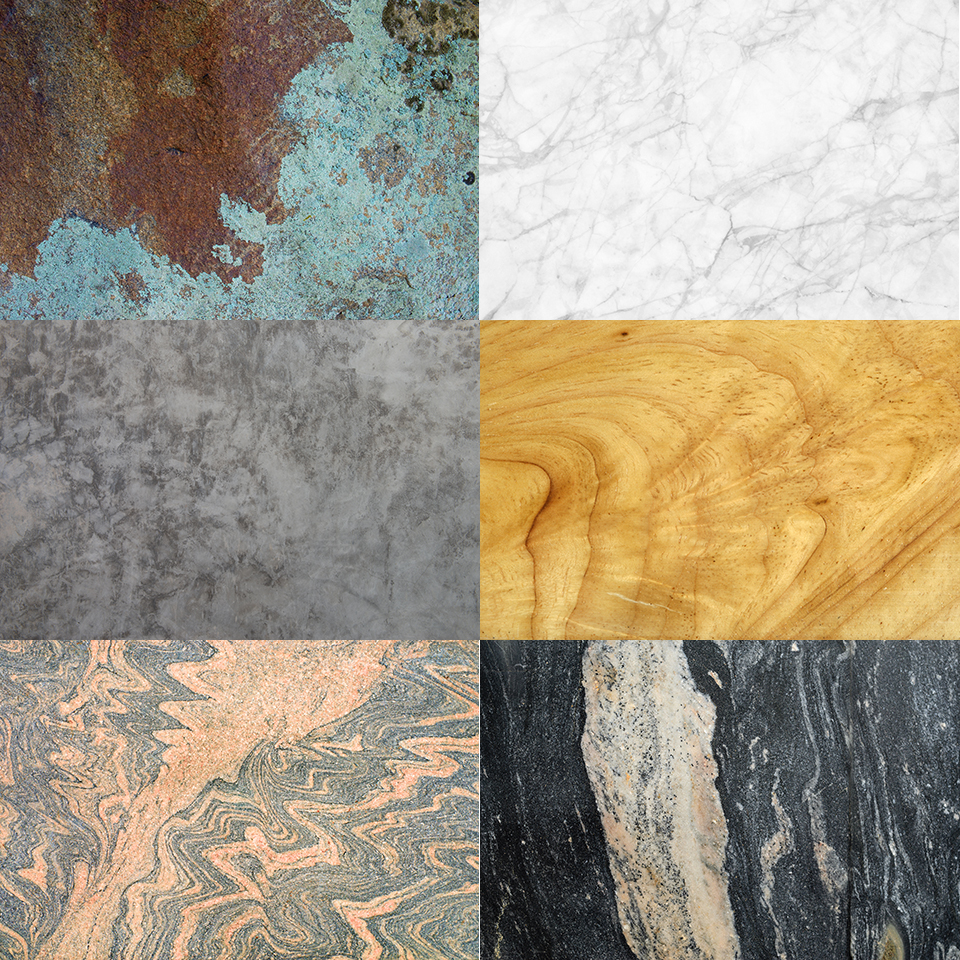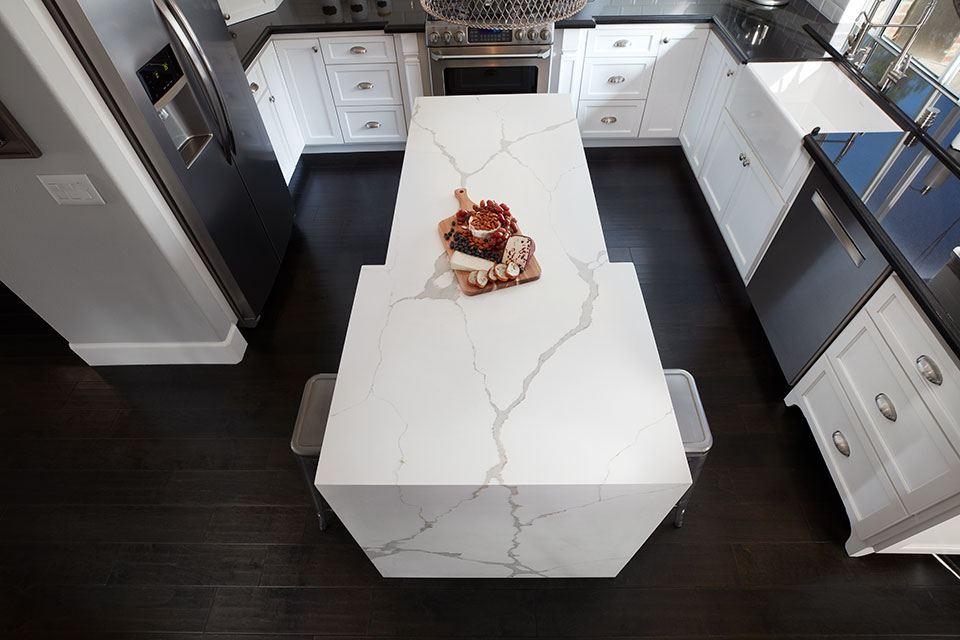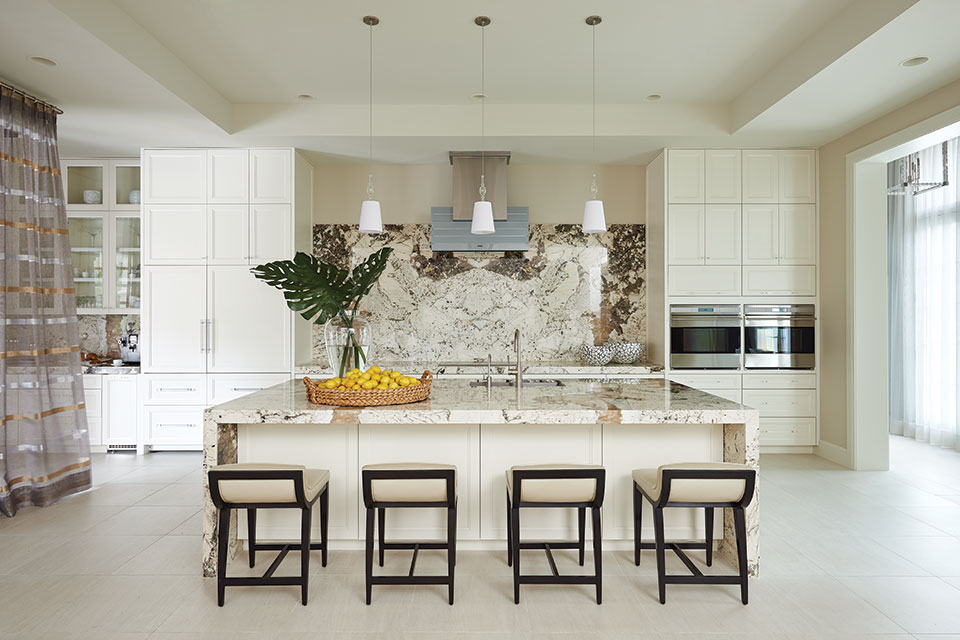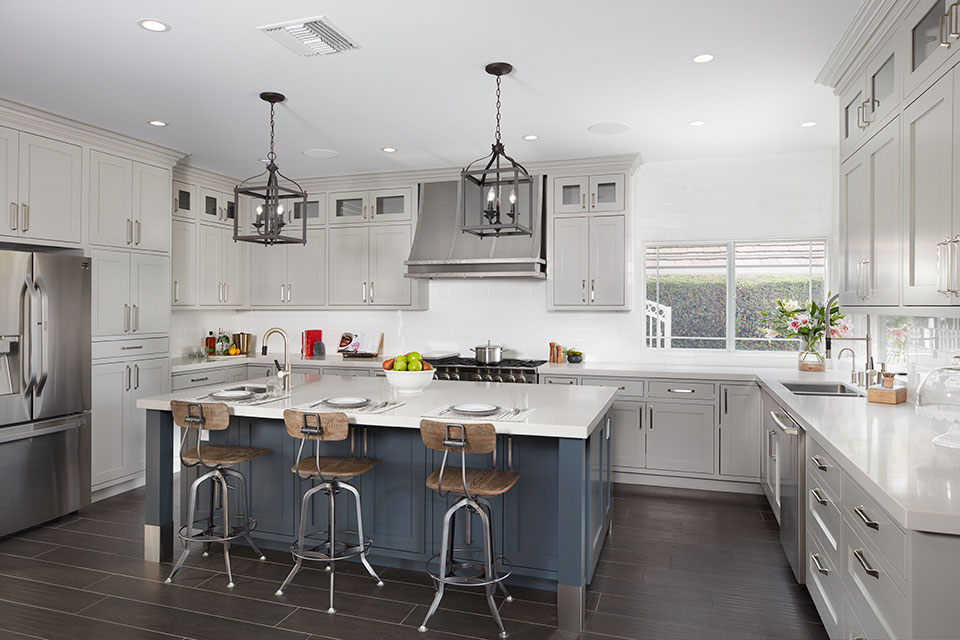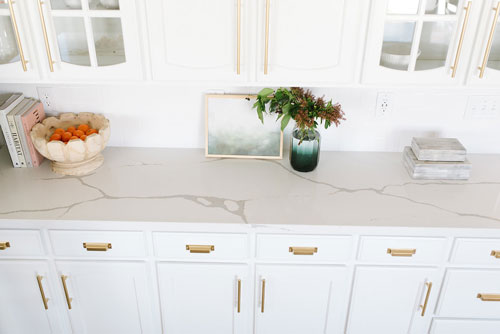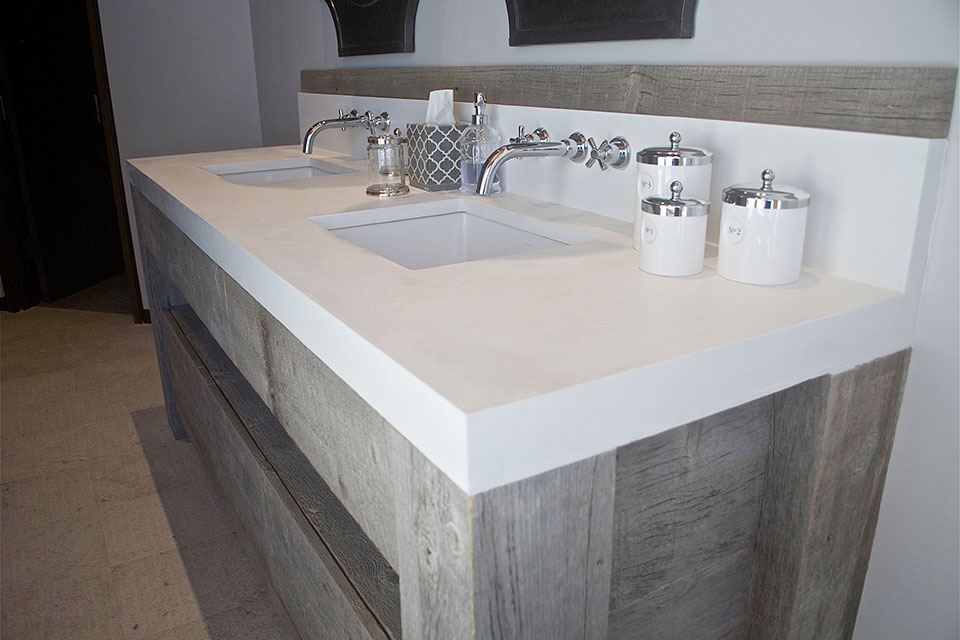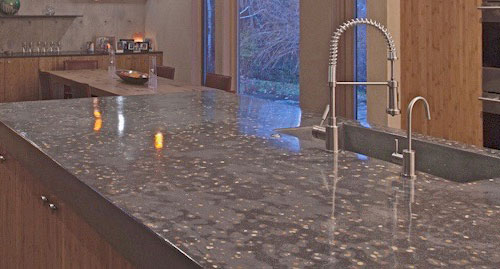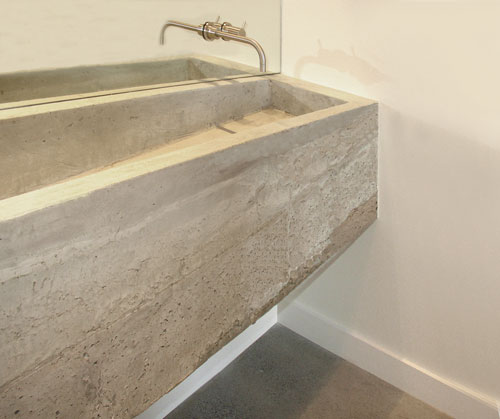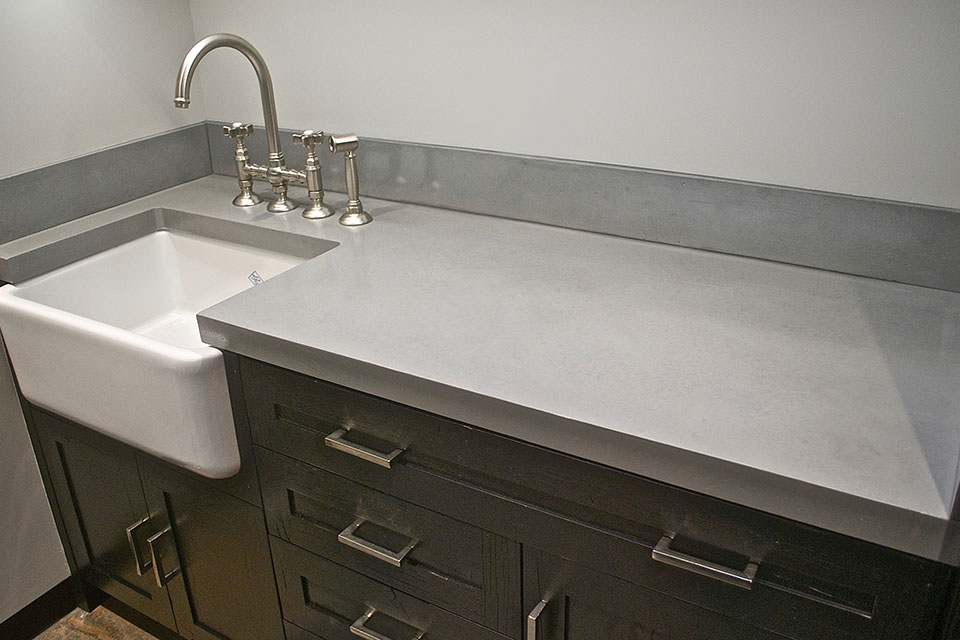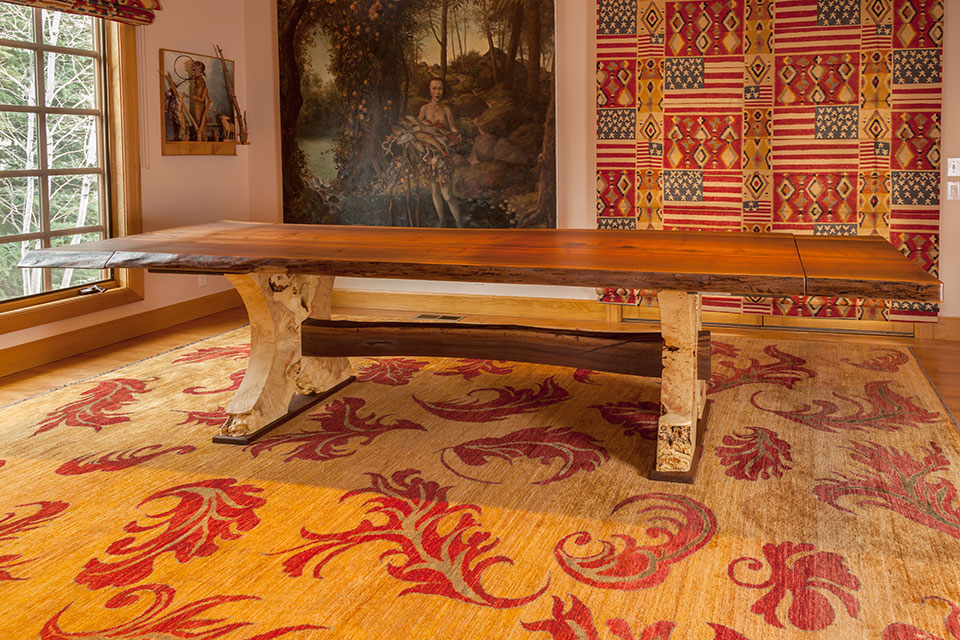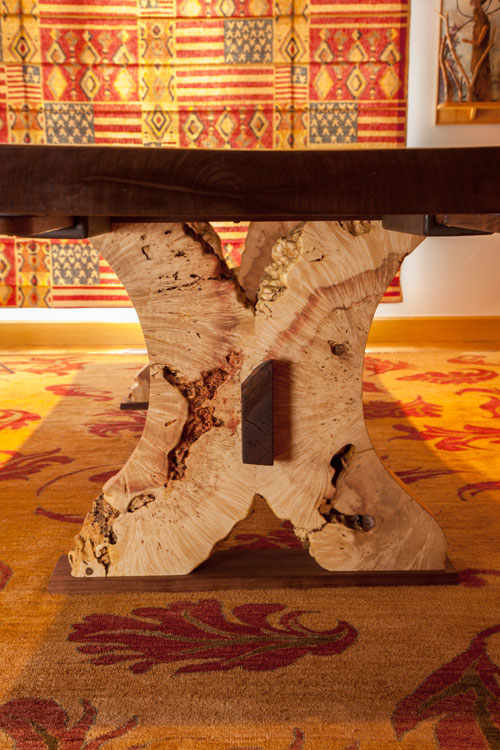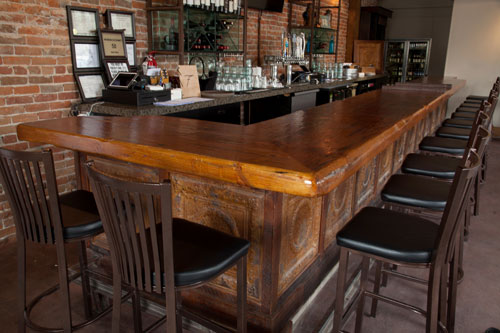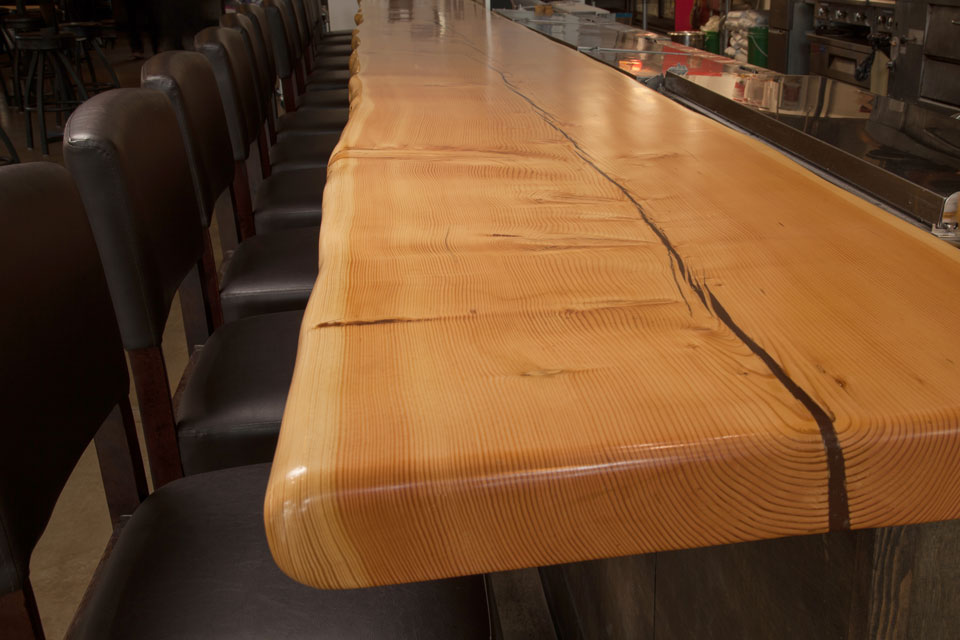Choosing Custom Countertops
CENTERPIECES, BUFFET LINES, AND ELBOWS FIND A PLACE ON COUNTERTOPS, AND MUCH OF THE COHESIVE DESIGN OF A HOME RESTS UPON COUNTERTOPS, AS WELL.
From bare utility to structured design, countertop shape, color, and material can be the bedrock for organizing the aesthetic of a bathroom or kitchen. Before getting to the fabrication and integration of a countertop into a space, homeowners, architects, and designers must first start with material. Should the slab be natural and quarried? Manmade and durable? Should it be custom-shaped and-colored from a concrete base? Or crafted from the forest? Whichever direction a buyer chooses, builders in the Sun Valley area have the most knowledge, variety, and availability to connect an owner with the right material.
The Magic of Manmade
Gina Garcia has been working at Sun Valley Rug & Tile for half a decade. During this time, she has seen the popularity of manmade materials skyrocket. “In past years, the majority of our kitchens called for granite,” she says. “But this year, more than half our tops have called for quartz. Caesar stone was one of the first companies to start producing manmade slabs, but now almost all our stone vendors have their own quartz lines.”
While Sun Valley Rug & Tile continues to serve its customers looking for natural stone tops, like granite, marble, or travertine, the onset of contemporary style demands the clean look derived from quartz materials. Engineered from natural silicon dioxide and synthetic materials, quartz blends loose rock and a binder to produce a material that is highly durable and incredibly customizable.
“Quartz gives you those really clean marble, limestone, or concrete looks without the maintenance. It is much less likely to etch or scratch, and is quite stain-resistant,” says Garcia. “Overall, it’s a bulletproof countertop that gives you a clean look.”
Adding to the popularity of quartz is the contemporary market’s call for neutral colors and clean lines. Garcia and the rest of the Sun Valley Rug & Tile team will often suggest neutral colors in countertops and cabinets with color in a backsplash when working with new builders. Whites and greys fall into that neutral palette and have experienced a surge in popularity alongside the rise of contemporary mountain style.
“Quartz gives you those really clean marble, limestone, or concrete looks without the maintenance. It is much less likely to etch or scratch, and is quite stain-resistant.” –
–Gina Garcia, Sun Valley Rug & Tile
“When working with a new client, we start by getting a feel for the person’s sense of style,” she says, adding that her favorite part of her job is meeting new people with varied and different tastes. Often, when the taste of the client doesn’t fit into just one or two categories, like rustic or contemporary, the vast selection of materials allows them to have the best of both worlds. “You can be rustic and have a white countertop in your house, something clean alongside something natural; this valley will always find a way to blend them both.”
In fact, while Garcia says that the split between rustic and contemporary is about 50 percent each way amongst her clients, a move back to natural looks appears to be on trend. “We’ve been seeing a lot of natural textures and natural stone slates that have a heavy texture to them,” she says. “People are going back to the basics, to stone or pebble looks.”
Just because clients want a natural look doesn’t mean that they have to give up the durability and low maintenance of manmade materials. Quartz can come with leathered or matte finishes to look like natural stone, or it can be paired with a warm-colored backsplash to achieve a natural balance with modern materials.
Garcia concludes, “We can do anything, any solid surface top. Today, the options are pretty much endless.”
“We can do anything, any solid surface top. Today, the options are pretty much endless.” –
–Gina Garcia, Sun Valley Rug & Tile
The Comfort of Concrete
A long-time artisan, valley local, and Decorative Concrete Hall of Fame member Jon Nasvik can vouch for the variability and use of concrete in a home. Working with concrete since he was 14, Nasvik designed his entire house from the substance and has made a career in sculpting, staining, and designing decorative concrete as the founder of Cliffhangers in Sun Valley.
“The industry is loaded with specialization,” he says, noting that most other concrete workers only do certain kinds of projects like polishing floors in supermarkets. “I do more than anyone would think. There’s such huge variety, which is incredibly stimulating and fun, even if it means that I have a huge supply of different products and tools to organize.”
“There is an earthiness to concrete. It’s not as cold and unfriendly as you think.”
–Jon Nasvik, founder of Cliffhangers and Decorative Concrete Hall of Fame member
Years ago, after first coming to the area to visit his sister, Nasvik fell in love with Sun Valley. As soon as he could find a place to stay, he drove to Idaho in an empty pickup truck and began building his life there, opening his business in 1991. While making a life for himself, he has also made a home for concrete against the backdrop of a mountainous environment.
“There is an earthiness to concrete,” he says, disproving that the material is only for abstract, contemporary design. “It’s not as cold and unfriendly as you think. The right processing can result in a warm, real feeling to a house. It’s more of the Earth than it is of the synthetic world.”
Indeed, the world of concrete is virtually endless in terms of shape, texture, color, and design. What got Nasvik into the business was his skill in making molds and stamps for concrete. One look at his work will tell you that concrete has more potential beyond creating flat, grey surfaces. Nasvik can use the material to shape rock-like formations, wood-feeling slabs, and all matters of shapes and tiles.
If his ability to stamp concrete got him in the business, his artistry with color and pattern has kept him there. After meeting with a new owner or designer, Nasvik will then decide if the project allows him to precast the cement and bring it in to install or if he needs to cast in place using form boards. The first usually corresponds to clean, crisp lines and smaller projects, while larger projects that require more texture or variation get casted in place.
“I then pour the cement over the surface, float it, trowel it, grind it, and coat it before getting color involved,” he says, describing his process. “If the customer wants variations I can stain it with tints of sealer, acrylic, or acid stain.”
Acid staining, a technique used in the Sun Valley Lodge in the ‘40s, has been popular in private and commercial markets for the rusty, organic tones it creates. The stain involves using a commercial acid product mixed with metal that, when it reacts with the chemistry of the concrete, creates earthy oranges, browns, and blacks. This technique is just one of the many ways to warm up the look of concrete, and Nasvik is always learning more.
“Just looking at concrete, you have a sense of strength and earth,” he says. “I’m 66 years old, I’ve been doing this since I was 14, and I still feel like there’s a lot to learn, and I’m excited about it.”
“Just looking at concrete, you have a sense of strength and earth. I’m 66 years old, I’ve been doing this since I was 14. I still feel like there’s a lot to learn, and I’m excited about it.”
–Jon Nasvik, founder of Cliffhangers and Decorative Concrete Hall of Fame member
Warming up with Wood
“The road goes on forever but the sanding never ends.” So reads the script on a door in Randy Edgar’s custom design wood shop in Bellevue, Idaho. The space is filled with slabs of fir and pine, knobby hunks of burl and grape vine, as well as the canoes, toboggans, bathtubs, and of course, countertops, that the shop creates. Working in the area since 1981, Edgars has recognizable work all over the valley. It includes ornate, Western design like much of the interior of the Pioneer Saloon, or long bar tops like that in the new Wise Guy Pizza location in Hailey.
“All of my art is functional; it does something,” he says. “Countertops are so utilitarian, you use them all of the time. I usually take a piece of wood and turn it into what it tells me to, and that can be a beautiful bar countertop.”
No doubt, his art is beautiful. Edgar has clients all over the country seeking his work for everything from furniture to construction design. But why, when there are so many options for cheap, durable materials on the market, should one choose wood for a countertop?
“Wood is warm,” answers Edgar. “With granite or steel, when you put your hands on it, it is cold and uninviting. Of course, wood is softer and gets damaged more easily than other materials, but the warmth of wood is comforting.”
In addition to installing the final product, what Edgar loves about custom wood pieces is the process of creating them. For large projects, the slabs are often too big for machines and require all work to be done by hand.
“To me, that’s the beauty of it,” he says. “You get this large piece of wood that might be a little warped and you make it dead flat, put a beautiful finish on it, and it comes out just perfect.” And, he has special ways of increasing the resistance to wear and tear on his work.
On countertop surfaces, like butcher-block, Edgar will use an oil finish that requires touch-ups from time to time to protect the wood from wear and tear. More ornate pieces like long bars will get a glossier shine. With pine, after letting his piece air dry, he fills any cracks in the surface with epoxy to harden the surface and increase the durability of the wood. The Wise Guy Pizza bar is made of fir and has a nice Varathane finish.
“All of my art is functional; it does something. I usually take a piece of wood and turn it into what
it tells me to, and that can be a beautiful bar countertop.”
–Randy Edgar
Another wonderful thing about wood? In a stylistic landscape such as the Sun Valley area, where tastes swing between rustic and contemporary on a regular basis, wood can fit in well with both styles. “Wood softens up contemporary looks,” explains Edgar. “It can look really nice to put a rustic slab of wood on top of a contemporary base.”
To Edgar, wood is a source of artistry, straight from organic material, that can connect a space to the outside in unusual ways. Considering that he sometimes gathers wood for his work from the Sawtooths, it’s hard to think of a more local, natural material for constructing one’s countertop.
In many ways, having too many choices can muddle the process of constructing a dream kitchen or design. However, through its variety of resources, closeness to products. and knowledge of manufacturers, Sun Valley gives homeowners plenty of opportunity to choose the perfect material for their countertop and make them feel at home.
